Elevate your Italian culinary experience with the irresistible allure of brown butter gnocchi, a soul-warming comfort dish that effortlessly blends rich flavors and silky textures to delight your taste buds. Originating in 16th-century Northern Italy, these delicate potato dumplings have evolved with variations like spinach and ricotta, making them a cherished part of Italian culture. The key? Nutty, caramelized brown butter that enhances the delicate gnocchi, finished with Parmesan and fresh herbs for an indulgent yet balanced meal. It's a simple yet impressive dish that showcases the versatility of homemade gnocchi – and if you keep reading, you'll discover the secrets to mastering this irresistible Italian comfort food.
Key Takeaways
- Brown butter enhances the delicate flavor of homemade potato gnocchi, creating a comforting and indulgent Italian dish.
- Gnocchi's humble origins and evolving variations showcase Italy's rich culinary heritage, often enjoyed with family and friends.
- The simple combination of browned butter, Parmesan, and fresh herbs elevates the gnocchi into a satisfying comfort food experience.
- Shaping the gnocchi with signature ridges allows for better sauce adherence, enhancing the overall taste and texture.
- This dish represents the essence of Italian home cooking, with its ability to inspire culinary exploration and appreciation for quality ingredients.
History
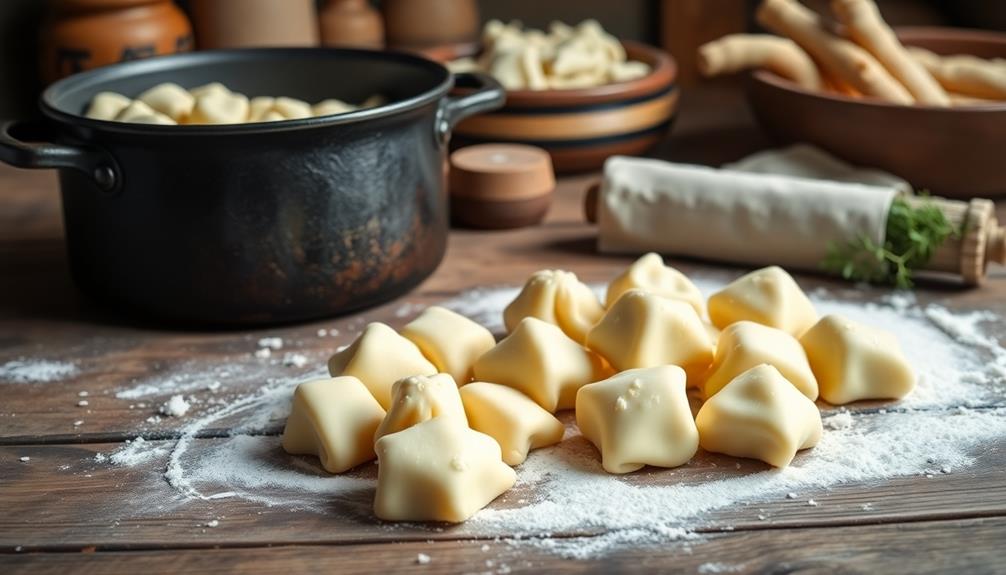
Gnocchi, the beloved Italian dumpling, has a rich history that dates back centuries.
These tender, pillowy bites of comfort have been delighting palates since the 16th century, when they first emerged as a staple in Italian cuisine. Originating in the northern regions of Italy, gnocchi were initially made with just a few simple ingredients – potatoes, flour, and eggs.
Over time, creative cooks experimented with all sorts of variations, incorporating everything from spinach and ricotta to pumpkin and chestnut.
Today, gnocchi remains a cherished part of Italian culture, with families gathering to make the dumplings together, often passing down recipes from generation to generation.
Whether you're enjoying them tossed in a fragrant brown butter sauce or paired with your favorite ragù, these delightful dumplings are a true taste of Italy's rich culinary heritage.
Recipe
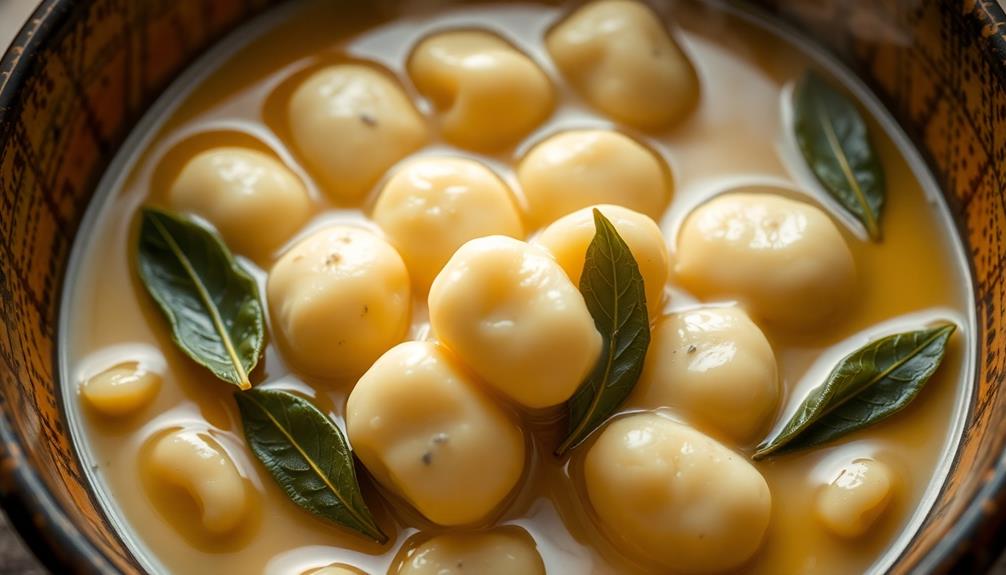
Brown Butter Gnocchi
Recipe
Gnocchi, those delicate potato dumplings, take on a new level of flavor when combined with the nutty, toasty notes of brown butter. This dish is a simple yet indulgent way to showcase the versatility of homemade gnocchi.
The key to this recipe is allowing the butter to gently brown, imparting a depth of flavor that complements the pillowy gnocchi beautifully. The dish is finished with a sprinkle of Parmesan cheese and freshly chopped herbs, creating a harmony of textures and tastes.
Ingredients:
- 1 lb homemade or store-bought gnocchi
- 1/2 cup (1 stick) unsalted butter
- 1/4 cup grated Parmesan cheese
- 2 tbsp chopped fresh parsley or basil
Cooking Instructions:
Bring a large pot of salted water to a boil. Cook the gnocchi according to package instructions, or until they float to the surface. Drain and set aside.
In a large skillet, melt the butter over medium heat, stirring occasionally, until it turns a deep golden brown and develops a nutty aroma, about 5-7 minutes.
Add the cooked gnocchi to the browned butter and toss gently to coat. Sprinkle with Parmesan cheese and chopped herbs, then serve immediately.
Tips:
- For best results, use high-quality, freshly grated Parmesan cheese.
- Experiment with different fresh herbs, such as thyme or oregano, to complement the flavors.
- Serve the brown butter gnocchi with a simple green salad for a well-balanced meal.
Cooking Steps
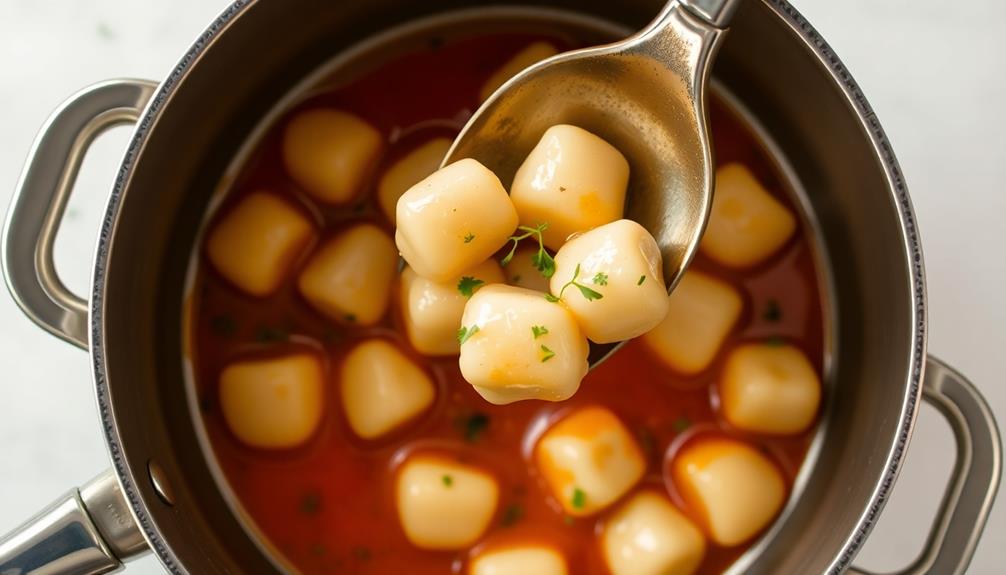
First, you'll combine the cooked potato, flour, and egg in a bowl to create a smooth dough.
Next, gently roll and shape the dough into bite-sized gnocchi.
Then, drop the gnocchi into boiling water and wait until they float to the surface, indicating they're cooked through.
Step 1. Combine Potato, Flour, and Egg
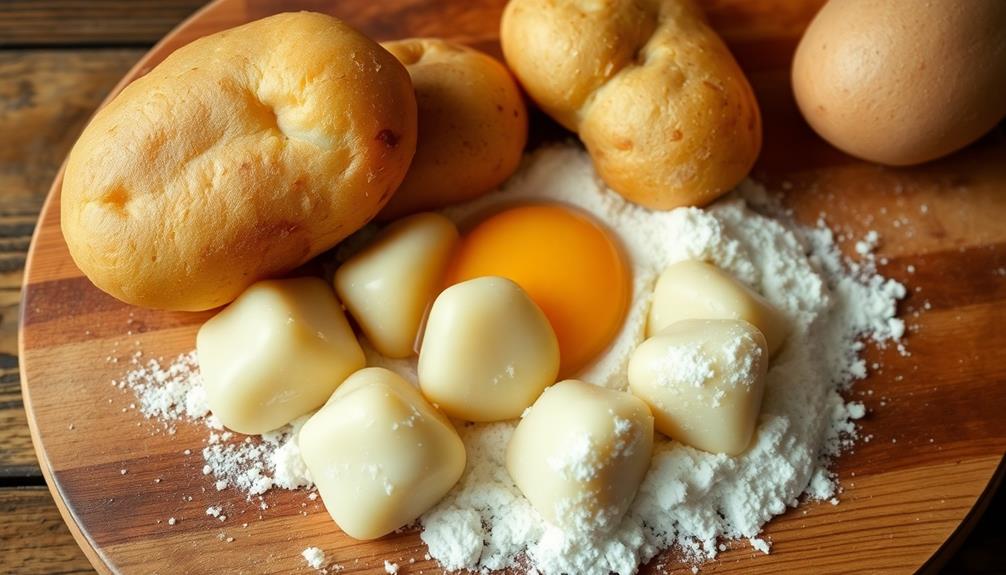
You'll want to start by cooking the potatoes until they're tender. Once they're soft, you'll peel and mash them until they're smooth and lump-free.
Now, it's time to combine the mashed potatoes with flour and a beaten egg. Gently knead the dough until it comes together into a soft, pliable ball. Be careful not to overwork it, or your gnocchi will become tough.
Next, you'll want to divide the dough into manageable portions and roll each one into long, thin ropes, about 1/2 inch thick. Using a sharp knife, cut the ropes into 1-inch pieces to form the gnocchi.
Gently place the gnocchi on a lightly floured surface, being careful not to let them stick together.
With the gnocchi prepped, you're ready to move on to the next step of cooking them in boiling water until they float to the top, about 2-3 minutes.
Drain and toss them with the delicious brown butter sauce you'll create. Get ready for a comforting and irresistible Italian feast!
Step 2. Shape Dough Into Gnocchi
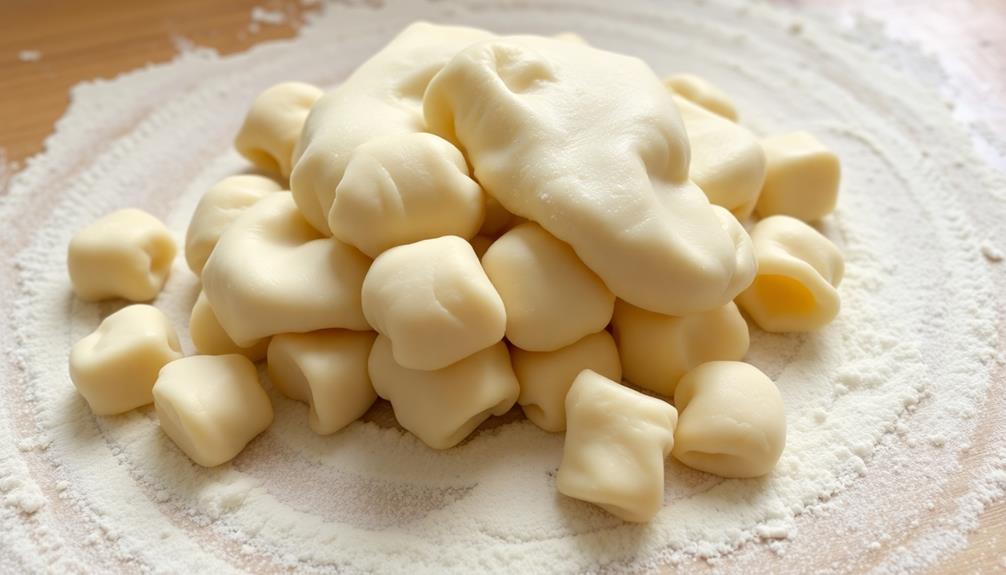
With the dough ready, divide it into manageable portions and roll each one into long, thin ropes about 1/2 inch thick.
Dust your work surface lightly with flour to prevent sticking, then use your palms to gently roll and stretch the dough into those perfect little ropes.
Once you've got them all shaped, use a knife or bench scraper to cut the ropes into 1-inch pieces.
Try to make them uniform in size so they cook evenly. As you cut, lightly toss the gnocchi pieces in more flour to keep them from sticking together.
Now comes the fun part – use a fork or your fingers to gently roll and press each piece, creating those signature ridges.
This not only looks beautiful, but it also helps the gnocchi hold onto the delicious brown butter sauce you'll be tossing them in later.
With all your gnocchi shaped and ready, it's time to cook them up and enjoy this comforting Italian dish.
Step 3. Boil Gnocchi Until They Float
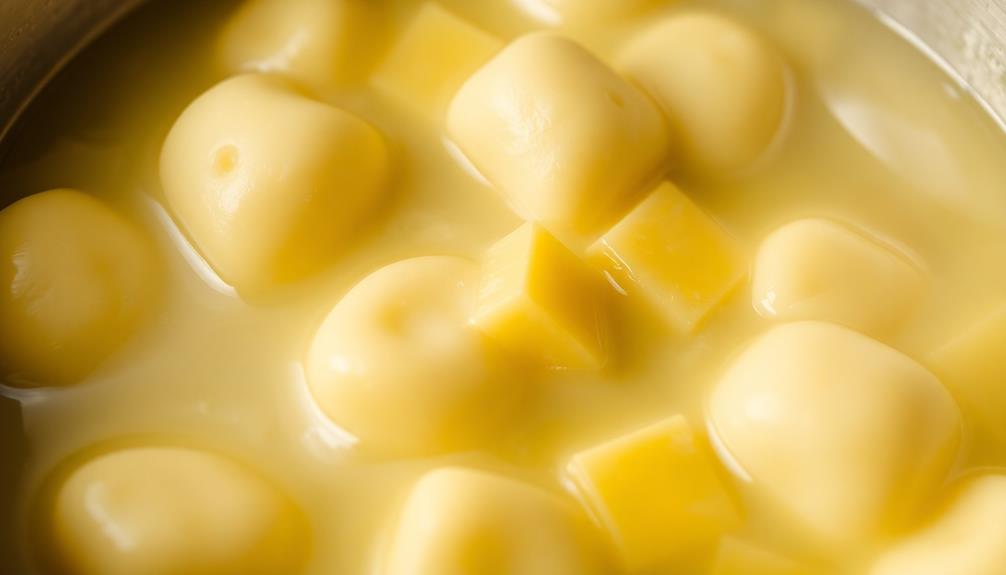
Bring a large pot of salted water to a boil over high heat.
Once the water is at a rolling boil, gently drop your freshly made gnocchi into the pot, one by one.
Watch as they sink to the bottom at first, then slowly start to float back up to the surface. This is the sign that they're cooked through!
Let the gnocchi float for about a minute or two, then use a slotted spoon to scoop them out.
Be gentle – you don't want to break these tender dumplings.
Transfer the cooked gnocchi to a plate or baking sheet, being careful not to let them stick together.
Repeat this process in batches until all your gnocchi are cooked.
The key is to work in small amounts, so you don't overcrowd the pot.
With a little patience and care, you'll have perfectly light and fluffy gnocchi, ready to toss with your brown butter sauce.
Mmm, can you smell that irresistible aroma already?
Step 4. Toss Gnocchi With Brown Butter
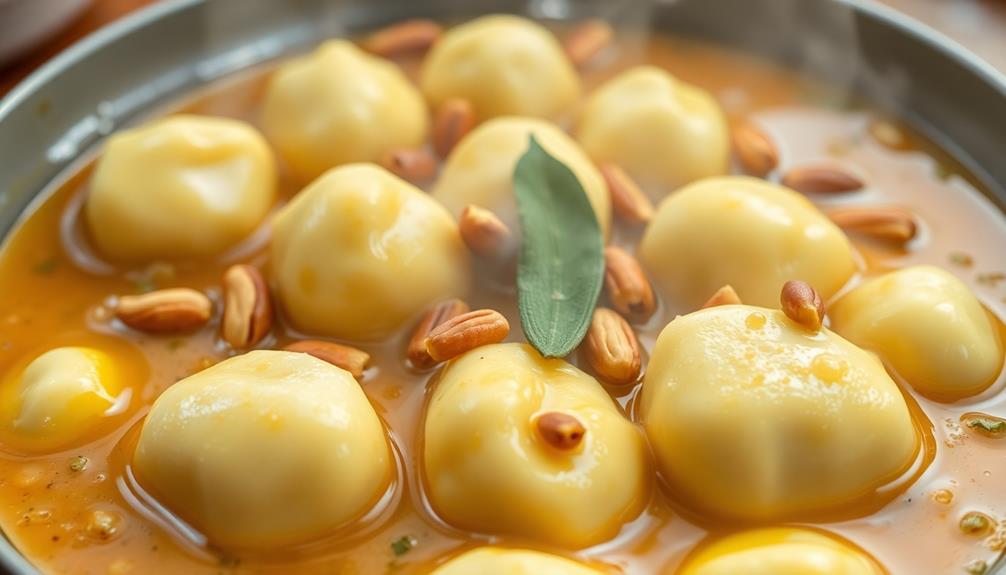
Once your gnocchi are cooked, it's time to toss them with the fragrant brown butter sauce. You'll want to work quickly, as the butter can go from golden perfection to burnt in a matter of seconds.
Grab a large skillet and melt the butter over medium heat. Watch it closely, swirling the pan occasionally, until the butter begins to foam and turn a beautiful golden-brown. The nutty aroma will fill your kitchen, making your mouth water in anticipation.
Carefully add the cooked gnocchi to the browned butter, gently tossing to coat each pillow-soft dumpling. The gnocchi will soak up all that rich, nutty flavor, transforming into a decadent delight.
Don't be afraid to let the gnocchi sizzle and crisp up a bit in the butter – this will create an irresistible texture contrast. Finally, finish with a sprinkle of freshly grated Parmesan cheese and a pinch of salt and pepper to taste.
Get ready to indulge in the ultimate Italian comfort food!
Step 5. Garnish With Fresh Parsley
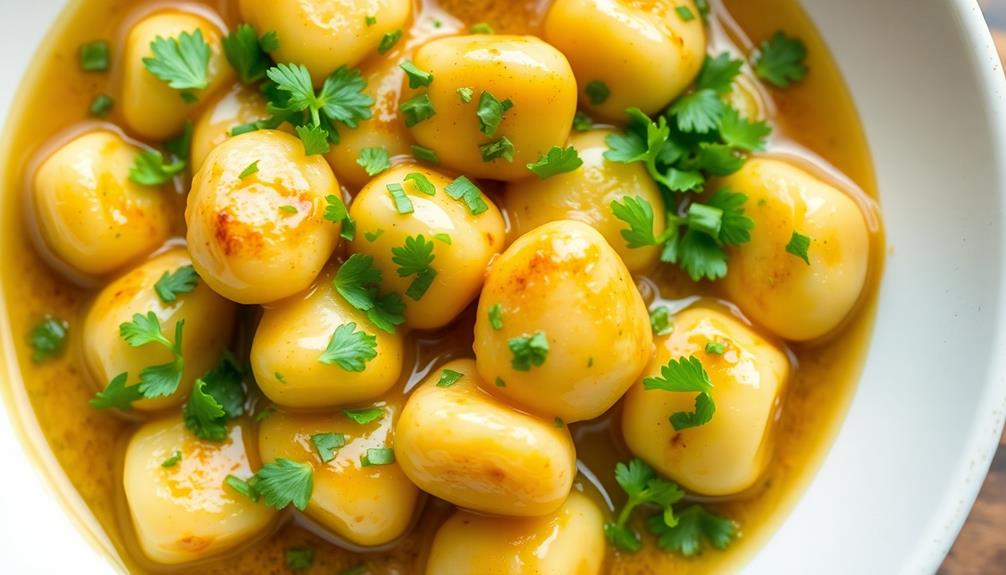
To finish this dish with a fresh pop of flavor, simply snip some fragrant parsley leaves and sprinkle them over the gnocchi.
The vibrant green of the parsley creates a beautiful contrast against the rich, golden brown of the butter. As you take a bite, the crisp, herbaceous notes of the parsley add a lively, cleansing counterpoint to the decadent, nutty butter.
The parsley's delicate texture also provides a lovely contrast to the tender, pillowy gnocchi. The combination of flavors and textures is simply irresistible.
With a final garnish of parsley, your Brown Butter Gnocchi is complete, ready to be enjoyed as the ultimate Italian comfort food. The fresh parsley elevates the dish, making each forkful a true delight for the senses.
Go ahead, take that first bite and savor the perfect harmony of flavors and textures that make this dish so delightfully irresistible.
Final Thoughts
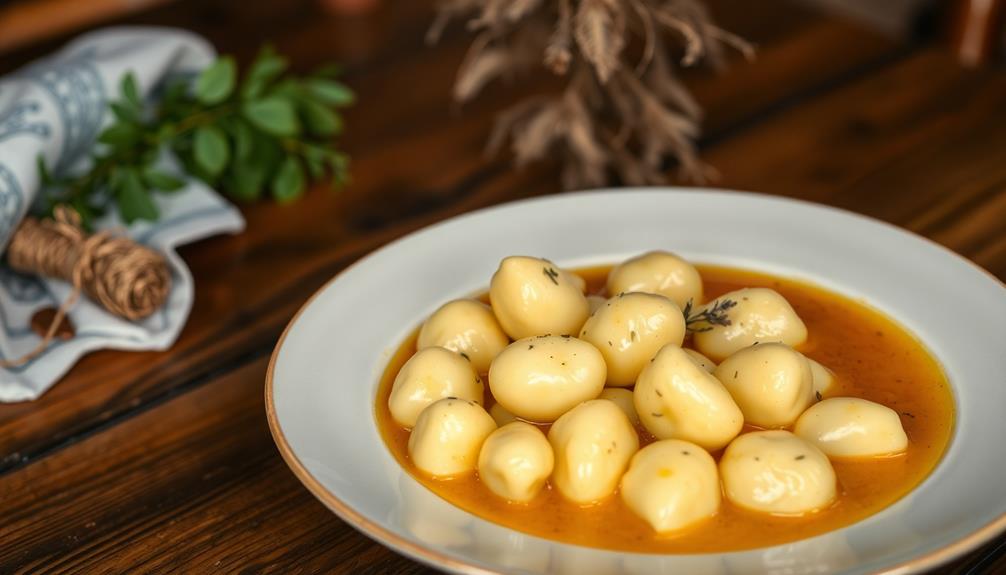
After enjoying the rich and indulgent brown butter gnocchi, you may find yourself reflecting on the overall experience.
The silky, golden-hued sauce coating the tender pillows of gnocchi has likely left you feeling satisfied and content. The interplay of the nutty, caramelized butter and the delicate potato dumplings is a match made in culinary heaven.
As you savor the final bites, you can't help but appreciate the simplicity and elegance of this classic Italian dish. The fresh parsley garnish adds a vibrant pop of color and a touch of herbal freshness, rounding out the flavors beautifully.
This comforting and soul-warming meal is sure to become a new favorite, one that you'll find yourself craving time and time again.
With its irresistible combination of textures and flavors, the brown butter gnocchi has undoubtedly left a lasting impression, inspiring you to explore more of the rich culinary traditions of Italy.
Frequently Asked Questions
What Is the Shelf Life of Homemade Gnocchi?
Your homemade gnocchi will keep in the fridge for 3-4 days, or in the freezer for up to 3 months. Be sure to store it properly to maximize its freshness and enjoyment.
Can I Use Regular Potatoes Instead of Russet?
You can absolutely use regular potatoes instead of russet potatoes for making gnocchi. The texture may be slightly different, but regular potatoes will still work well, producing light and fluffy gnocchi. Just be sure to cook them thoroughly before mashing.
Is It Possible to Freeze Brown Butter Gnocchi?
Yes, you can freeze brown butter gnocchi. The key is to par-cook the gnocchi before freezing them. This helps them retain their shape and texture when you reheat them later. Just be sure to freeze them in a single layer on a baking sheet.
How Do I Reheat Leftover Brown Butter Gnocchi?
To reheat leftover brown butter gnocchi, you can place it in a skillet over medium heat, adding a splash of broth or cream to prevent it from drying out. Stir until heated through, then serve and enjoy.
Can I Substitute Any Other Cheese for Parmesan?
Sure, you can substitute other cheeses for the Parmesan in your dish. Try using pecorino, asiago, or even a blend of hard, aged cheeses. Just adjust the amount to suit your taste preferences.










